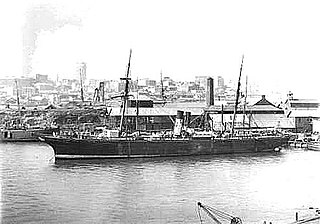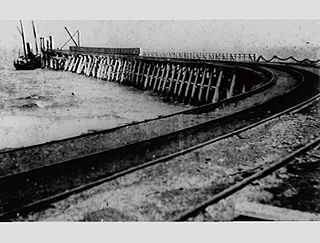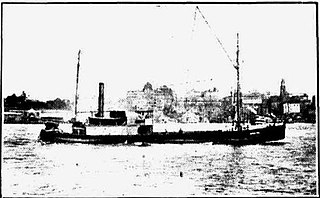
HMAS Adelaide was the lead ship of the Adelaide class of guided missile frigates built for the Royal Australian Navy (RAN), based on the United States Navy's Oliver Hazard Perry-class frigates. She was built in the United States and commissioned into the RAN in 1980.

A ship is scuttled when its crew deliberately sinks it, typically by deliberately opening holes in its hull.

Fairlight is a suburb of northern Sydney, in the state of New South Wales, Australia. Fairlight is located 13 kilometres north-east of the Sydney central business district in the local government area of Northern Beaches Council and is part of the Northern Beaches region.

The Dee Why and Curl Curl, were two identical steam ferries servicing Sydney Harbour's Circular Quay to Manly service. Both commissioned in 1928, they were the largest ferries on Sydney Harbour until the 1938 introduction of the South Steyne.

Lady Elizabeth is a wrecked iron barque of 1,155 tons built by Robert Thompson Jr. of Southwick, Sunderland and launched on 4 June 1879. Robert Thompson Jr. was one of the sons of Robert Thompson Sr. who owned and operated the family ran shipyard J. L. Thompson & Sons. Thompson Jr. eventually left the family business in 1854 to start his own shipbuilding business in Southwick, Sunderland. The ship was built for John Wilson as a replacement for the 658-ton, 1869-built barque Lady Elizabeth which sank off Rottnest Island, Western Australia in 1878.
The Advance was an iron screw steamer tug built in 1884 that was wrecked when she collided with Inverna off Catherine Hill Bay, New South Wales, Australia, on 25 December 1908.
The Advance was a composite schooner built in 1874 at Auckland, New Zealand, that was wrecked when she drifted onto rocks at Henrys Head, Botany Bay, New South Wales, Australia, on 12 June 1902, whilst carrying ballast between Wollongong and Newcastle, New South Wales.

The Alhambra was an iron steamer screw built in 1853 by Samuda Brothers at Cubitt Town, London. It was wrecked in a collision off Newcastle, near Nobbys Head, New South Wales, on 30 June 1888.

City of Adelaide was an iron-hulled ship that was launched in Scotland in 1863, spent a long career in Australian passenger and cargo service, and sank off the coast of Queensland in 1916. She served with several Australian shipowners, including the Australasian Steam Navigation Company, Australasian United Steam Navigation Company and Howard Smith Company.

The Merksworth was an iron steamer screw built in 1874 at, Paisley, that was wrecked when it swamped whilst carrying coal between Newcastle and Sydney and was lost off Newcastle, Stockton Beach, New South Wales on 7 May 1898.

Koompartoo was a 1922 Sydney Ferries Limited K-class ferry later converted to a Royal Australian Navy boom defence vessel. Koompartoo, described in the press as a "Dreadnought for the Milsons Point run" and "a titan amongst ferries", was along with her sister ferry, Kuttabul, the highest capacity ferries ever on Sydney Harbour.

Kuramia was a "K-class" ferry on Sydney Harbour. Commissioned in 1914, the timber-hulled steamer was built for Sydney Ferries Limited during the early twentieth boom in cross-harbour ferry travel. At 353 tons, she was the largest wooden ferry on Sydney Harbour.
Herald of the Morning was a three-masted square-rigged sailing ship, built in 1853 or 1854 at Saint John, New Brunswick, Canada, expressly for the Australia run. The contemporary Melbourne press described her as 'a fine ship of 1292 tons register'

The Nimbin was a steel screw steamer built in 1927 at Copenhagen, that was the first motor vessel placed into the New South Wales coastal trade. It was owned and operated by the North Coast Steam Navigation Company and was the first Australian registered merchant ship to be lost during World War II when it struck a mine laid by the German auxiliary cruiser Pinguin. The Nimbin was on its way from Coffs Harbour to its home port, Sydney, with a cargo of bundled three-ply timber and a cargo of pigs. One third of the ship was blown away and it sank in three minutes. Seven men were killed. The remaining thirteen clung to bundles of plywood. Some hours later an air force plane from RAAF Base Rathmines saw the survivors and directed the coastal ship SS Bonalbo to the scene to retrieve them.

The Herald was an iron paddle steamer imported as frames from the United Kingdom and assembled in 1855 by Richard Johnson in Sydney Harbour, New South Wales, Australia, where she was registered. The Herald is one of the earliest iron paddle wheel steamers built in Australia, where she operated within Sydney Harbour. She was initially used on the fledgling North Shore route between Dawes Point and Blues Point by the newly formed North Shore Steam Company; however, due to not enough traffic to make her financially viable, she often performed tug duties. Eventually the North Shore Steam Company was wound up; the vessel was put up for sale but continued picking up business wherever it was available, operating as a tug, ferry, excursion boat and cargo vessel.
SS Kate was a wooden carvel screw steamer built in 1883 at Balmain that was twice struck and sunk by Port Jackson & Manly Steamship Company ferries.
The coastal coal-carrying trade of New South Wales involved the shipping of coal—mainly for local consumption but also for export or coal bunkering—by sea to Sydney from the northern and southern coal fields of New South Wales. It took place in the 19th and 20th centuries. It should not be confused with the export coal trade, which still exists today. There was also an interstate trade, carrying coal and coke to other Australian states that did not have local sources of black coal.

Sixty-miler (60-miler) is the colloquial name for the ships that were used in the coastal coal trade of New South Wales, Australia. The sixty-milers delivered coal to Sydney from ports and ocean jetties to the north and south of Sydney. The name refers to the approximate distance by sea—actually 64 nautical miles—from the Hunter River mouth at Nobbys to the North Head of Sydney Harbour.

The Queen Bee was a wooden carvel Twin-screw steamer built in 1907 at the Rock Davis shipyard at Blackwall, New South Wales, that was wrecked when she sprang a leak whilst carrying coal between Newcastle and Sydney. She was lost off Barrenjoey Head, Broken Bay, New South Wales on 2 September 1922.

Kookooburra was a "K-class" ferry on Sydney Harbour. Commissioned in 1907, the timber-hulled steamer was built for Sydney Ferries Limited during the boom in cross-harbour ferry travel prior to the opening of the Sydney Harbour Bridge. She was retired from Sydney Harbour service in 1947 after which she was sent to Newcastle. She is thought to have been broken up in 1959.















